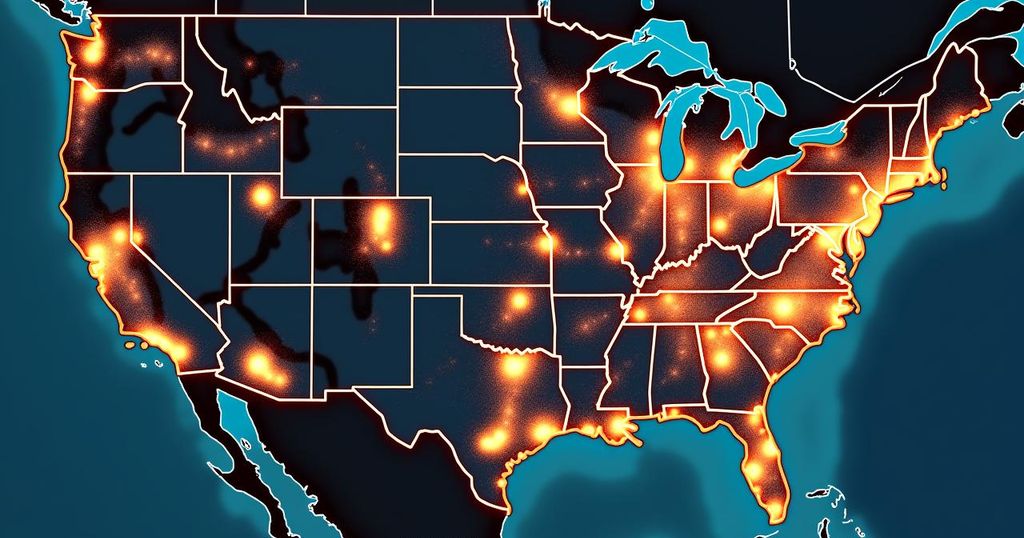Hurricane Helene: A Catastrophic Disaster Across Six States

Hurricane Helene made landfall as a Category 4 hurricane, causing extensive damage across six states, particularly through its deadly storm surge and unprecedented rainfall. With 230 fatalities reported, Helene became the deadliest inland hurricane on record, emphasizing the need for a reevaluation of hurricane risk assessments in the context of a warming climate.
Hurricane Helene, a storm of unprecedented scale and intensity, wreaked havoc across six states in late September 2024. This tropical cyclone was marked not only by its powerful winds and torrential rainfall but also by an extensive surge that led to catastrophic conditions extending over 500 miles inland from the Floridian coast. Tragically, Hurricane Helene claimed the lives of at least 230 individuals in Florida, Georgia, South Carolina, North Carolina, Tennessee, and Virginia as it devastated communities, eroded infrastructure, and submerged entire towns. The storm surged significantly, impacting Florida’s coast with damage reported along hundreds of miles. As recovery efforts commenced, another looming hurricane threatened the same regions—Hurricane Milton, forecast to make landfall shortly after Helene. Surprisingly, the majority of Helene’s casualties were not coastal residents, but individuals situated further inland who were unprepared for the deluge of over 20 inches of rain that transformed streams and rivers into torrents. As a geographer and climatologist studying hurricane history in South Carolina, I recognize Helene as the deadliest inland hurricane recorded, surpassing Hurricane Agnes of 1972, which resulted in 128 deaths in the northeastern United States. Furthermore, Helene stands as the third deadliest hurricane since operational forecasting began in the 1960s, trailing only behind Hurricanes Katrina and Camille. Meteorological analysis underscores three critical components of hurricanes: wind intensity, storm surge, and rainfall. These elements coalesced in Helene to produce a disaster that far transcended its wind speed. Hurricane Helene struck the Big Bend area of Florida as a Category 4 hurricane with sustained winds reaching 140 mph. Its rapid movement northward—at approximately 30 mph post-landfall—coupled with its expansive size, enabled its winds to cause damage even in regions such as Georgia and South Carolina, which are typically spared from such fierce conditions. Power outages affected over 2 million homes, with many still awaiting restoration a week later. Valdosta, Georgia, experienced winds nearing Category 2 intensity, infrequently seen in that region. The extensive size of Hurricane Helene, comparable to that of Hurricane Katrina at about 400 miles across, significantly contributed to the severity of its storm surge, which peaked around 15 feet in the Big Bend area—one of the highest recorded surges in regions dating back to the mid-1800s. Cedar Key reported a surge of around 9.3 feet, marking a record high for the area in the 20th century. Furthermore, Tampa Bay experienced a surge exceeding six feet, causing widespread damage and claiming twelve lives. Helene’s most severe impact, however, radiated far inland. In the mountainous areas, the terrain catalyzed the rainfall through orographic uplift, leading to astonishing precipitation levels that exacerbated flooding. Asheville, North Carolina, witnessed the French Broad River crest at 24.67 feet, exceeding a previous record set in 1916. The flooding also extended across Upstate South Carolina, with reports of 8 to 24 inches of rain resonating throughout the region. Atlanta registered an alarming 11.2 inches within a 48-hour timeframe. The devastation wrought by Hurricane Helene serves as a vital reminder that hurricanes cannot solely be evaluated according to wind speed. The Saffir-Simpson scale, which primarily classifies storms by wind intensity, fails to capture the full spectrum of a hurricane’s potential devastation. Though rated a Category 4, Helene’s impact rivaled some of the most calamitous hurricanes in history. Climate change is altering hurricane risks, as warmer ocean temperatures and increased humidity create a breeding ground for more intense and destructive storms, suggesting that Helene’s extraordinary impacts may become indicative of future hurricanes.
Hurricane Helene was an extraordinary tragical event characterized by its unprecedented scale and catastrophic impact across six states in the U.S. on September 26, 2024. The storm was significant due to its combination of high wind speeds, extensive storm surge, and heavy rainfall, resulting in widespread devastation that extended remarkably inland beyond coastal areas. It was noted for being the deadliest inland hurricane on record, surpassing previous disasters in terms of fatalities and impact, thus providing crucial lessons about the dangers of hurricanes and how they are assessed in the context of an evolving climate.
In conclusion, Hurricane Helene represented a formidable convergence of destructive forces that caused substantial loss of life and property across multiple states, particularly away from coastal regions. This disaster underscores the imperative for a comprehensive understanding of storm behavior and impacts beyond traditional metrics such as wind speed. The changing climate may herald a new era of increasingly potent hurricanes, warranting enhanced preparation and resilience strategies in vulnerable communities.
Original Source: theconversation.com






